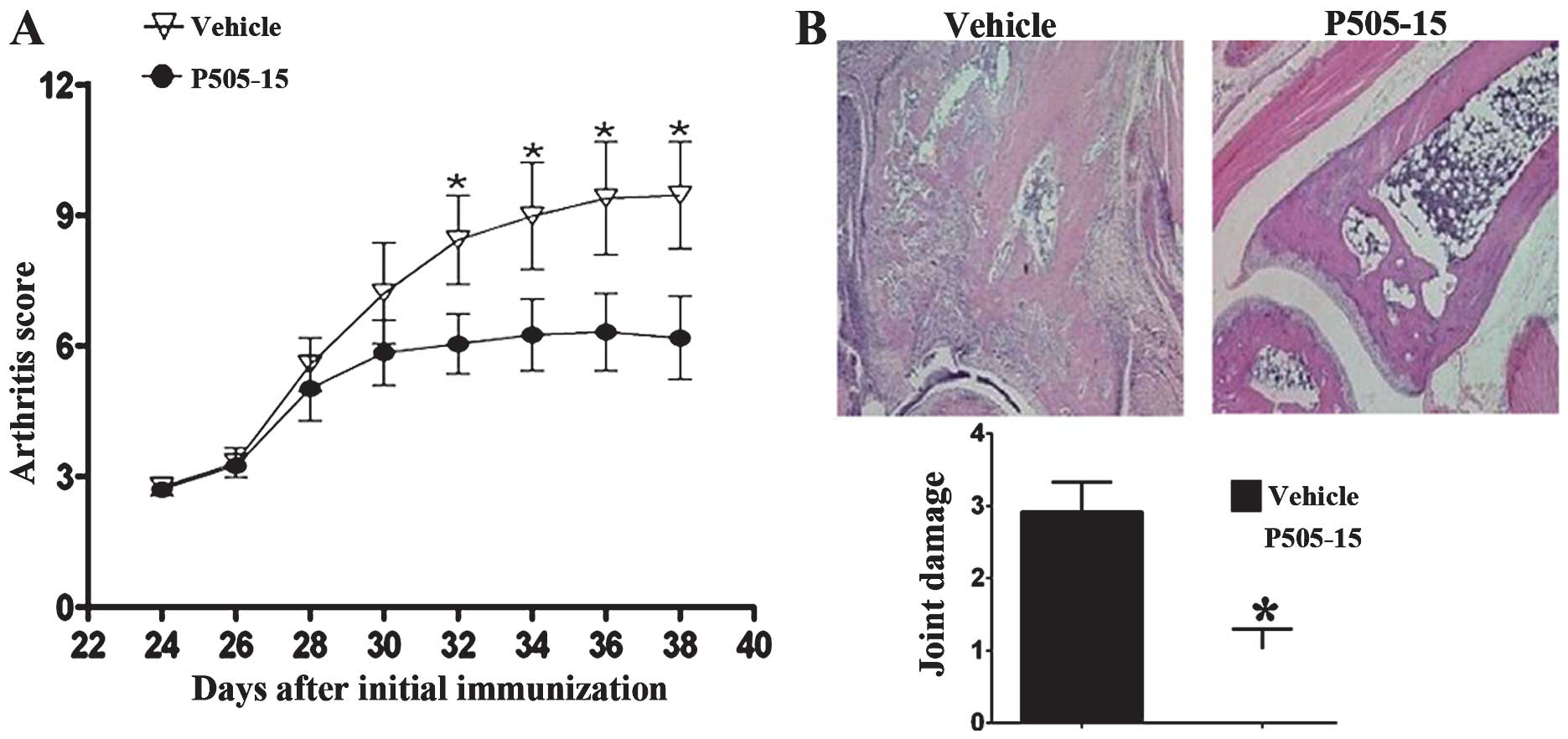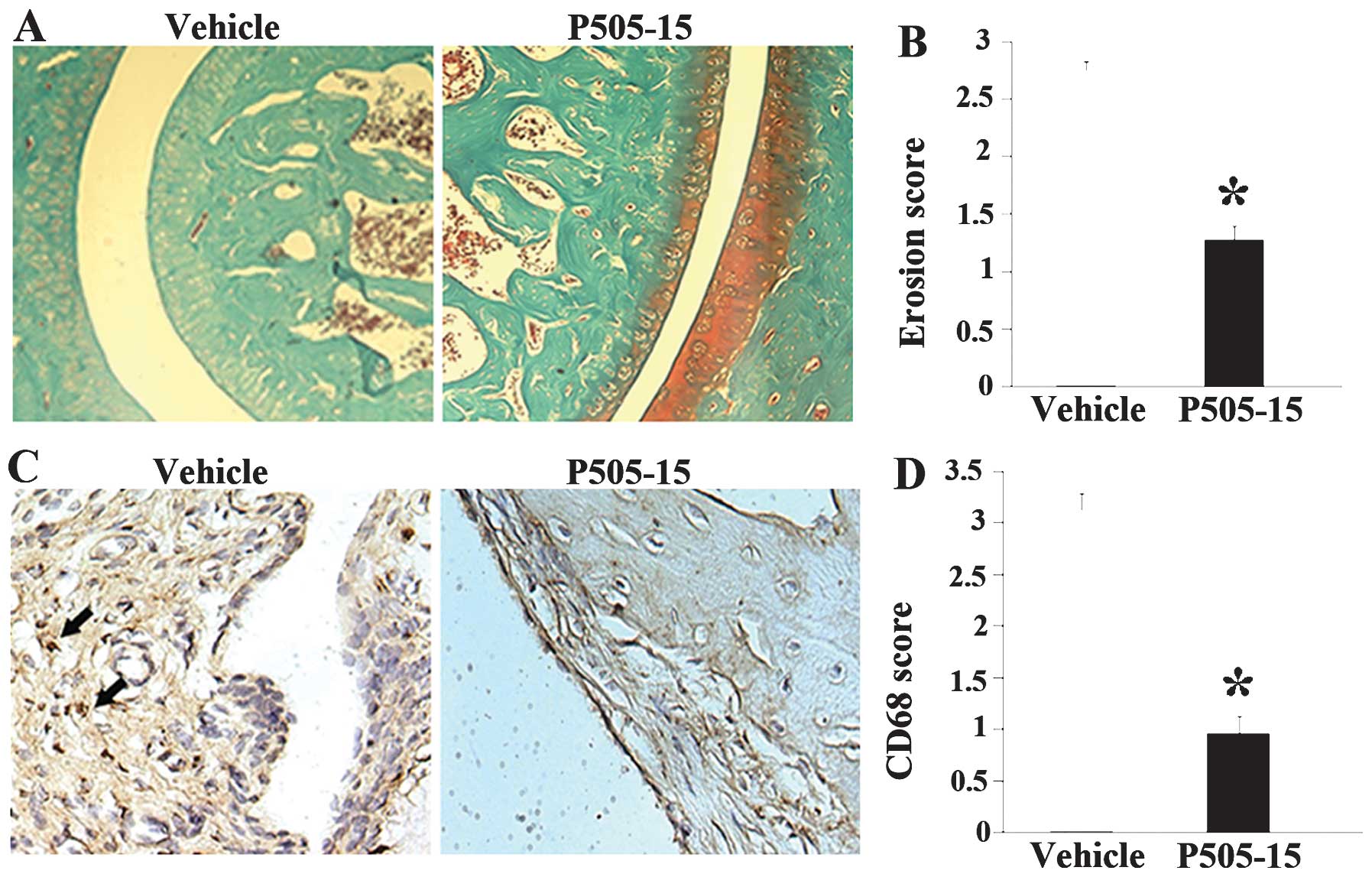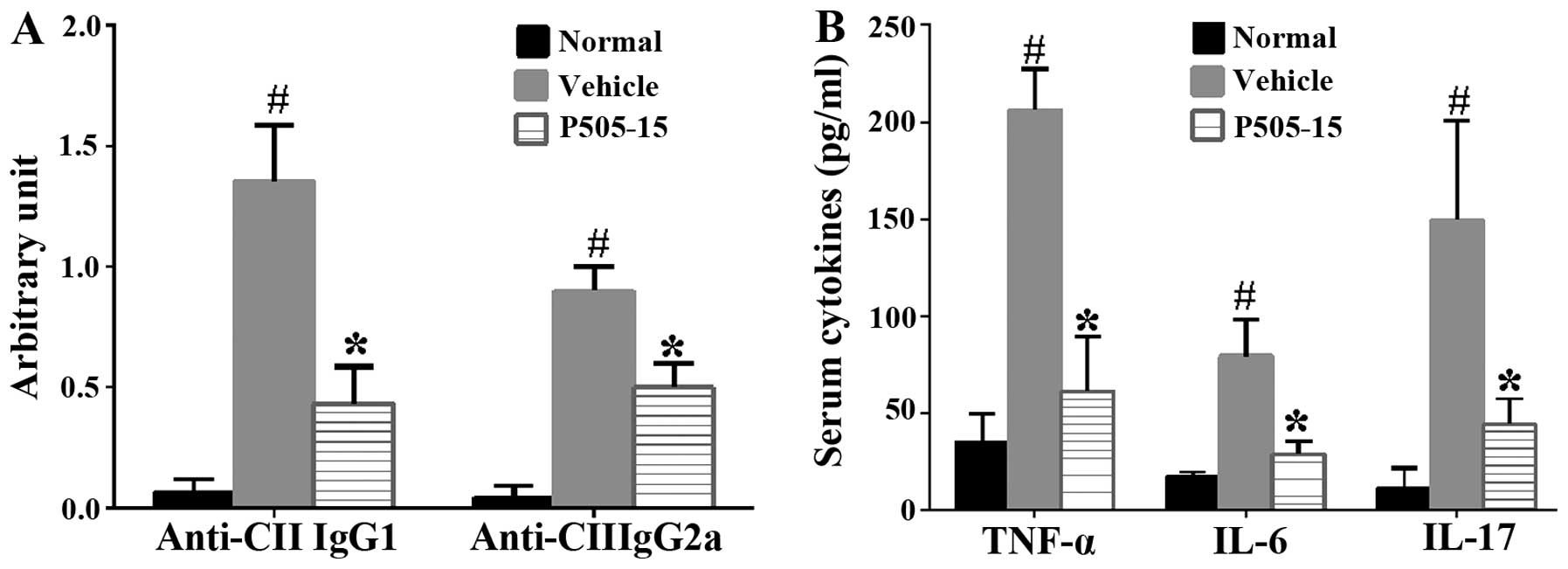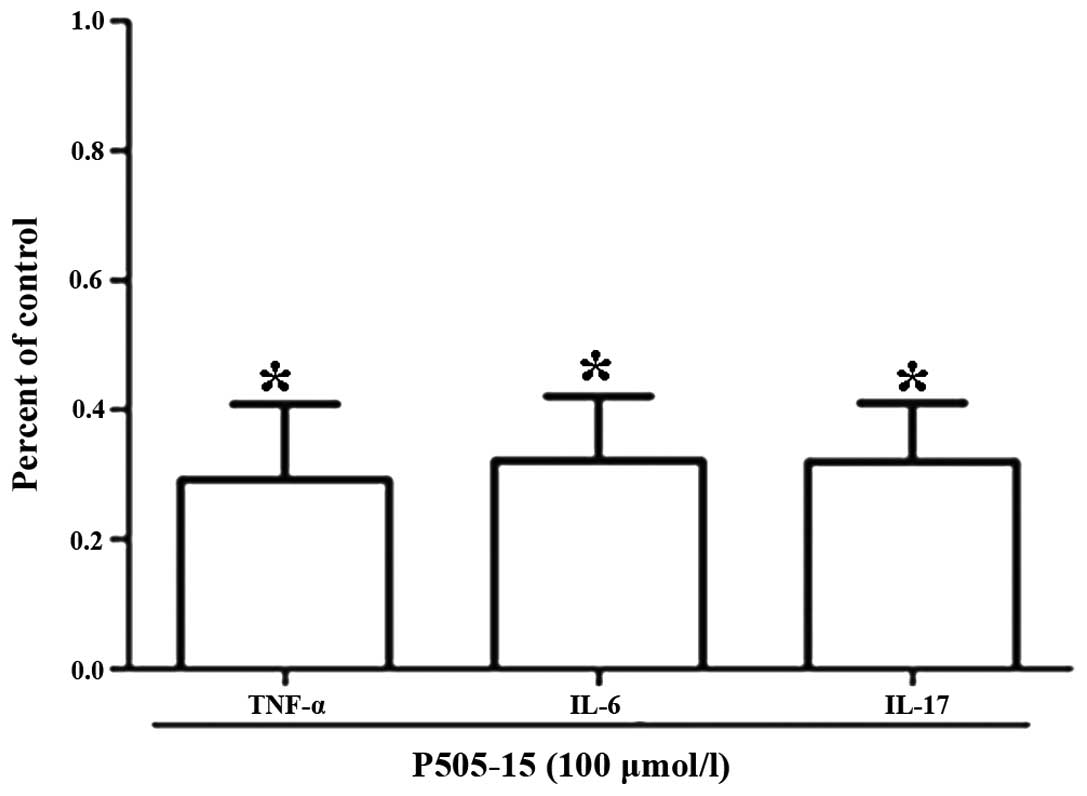Selective spleen tyrosine kinase inhibition delays autoimmune arthritis in mice
- Authors:
- Published online on: May 8, 2015 https://doi.org/10.3892/mmr.2015.3759
- Pages: 2902-2906
Abstract
Introduction
Rheumatoid arthritis (RA) is a systemic autoimmune disease characterized by the hyperplasia of synovial tissue and progressive destruction of articular cartilage, bone and ligaments (1–2). The pathogenesis of RA is a complex process mediated by an interdependent network of cytokines, proteolytic enzymes and prostanoids (3). There thus remains a tremendous unmet clinical requirement for more effective therapeutic strategies, with a goal of sustained remission for a greater number of patients with RA.
Current therapeutic strategies pursued by the biopharmaceutical industry include those that target the key kinases involved in the pathogenesis of RA. One such enzyme is the spleen tyrosine kinase (SYK), which is a master regulator in coupling activated immunoreceptors to the mobilization of downstream signal transduction cascades that affect diverse biological functions (4). Given the central role of SYK in transmission of antigen receptor signals that are critical for autoantibody production and the various innate immune effector functions, pharmacological inhibition of the catalytic function of SYK is expected to have pleiotropic anti-inflammatory effects in the pathogenesis of autoimmune disorders (5).
The present study explored whether the selective SYK inhibitor P505-15 impacted the development of collagen-induced arthritis (CIA) disease in vivo in mice. The results of the present study indicated that P505-15 may serve as a lead candidate for further development of selective SYK inhibitors for the potential treatment of RA.
Materials and methods
Animals
A total of 24 male DBA1/J mice (28–30 g; 8 weeks old) were obtained from Charles River Breeding Laboratories (Wilmington, MA, USA). All animal experiments were approved by the Institutional Animal Use Committee of Shandong University (Jinan, China). The study was approved by the ethics committee of Shandong Provincial Hospital, Shandong University (no. G2015698). The mice were housed with a 12-h light/dark cycle. They had ad libitum access to food and water in cages (n=6) under controlled temperature and humidity.
CIA induction
To induce CIA in DBA1/J mice as previously described (6), type II collagen (CII; Chondrex, Redmond, WA, USA) was dissolved overnight in 0.1 N acetic acid (4 mg/ml; (Chondrex) with gentle rotation at 4°C. The mice were injected intradermally at the base of the tail with 100 μg CII emulsified 1:1 in complete Freund’s adjuvant (Chondrex) and then received a second injection with 100 μg CII emulsified 1:1 in incomplete Freund’s adjuvant 21 days later.
Assessment of arthritis
Clinical arthritis scores were evaluated using a scale of 0–4 for each limb as previously described (7). Hind paw thickness was measured with an electric caliper placed across the ankle joint at the widest point. The paw thickness index was defined as the percent increase in the diameter of the arthritic ankle at specific time-points as compared with the diameter determined on day 21. On day 38, the mice were sacrificed, and joint tissue samples from each animal were harvested for end-point histological analysis.
Administration of P505-15
On day 24 after the first immunization, CIA mice (n=12 per group) received oral doses of vehicle (0.5% methylcellulose in water) or P505-15 (15 mg/kg) twice daily for 14 days as previously reported (8). On day 38, mice were anesthetized by subcutaneous injection of ketamine (Fort Dodge Animal Health, Webster County, IN, USA) and exsanguinated via cardiac puncture. Joints were stained with hematoxylin and eosin (H&E) for histology.
Histological assessment
Mouse joint tissue specimens from mice with CIA were fixed with 10% formalin, decalcified for 15 days in 10% EDTA, dehydrated and embedded in paraffin. Sections (6 μm) were stained with H&E and Safranin O-fast green for light microscopy (Labophot-2; Nikon, Tokyo, Japan). The mouse joint sections were scored for changes in synovial inflammation and bone erosion on a scale of 0–4 as described in the previous literature (7). Rabbit anti-mouse monoclonal anti-CD68 antibody (1:2,000 dilution; cat. no. 76308; Cell Signaling Technology, Beverly, MA, USA) incubated for 2 h at 37°C was used to identify the synovial macrophages. Safranin O-fast green staining was scored 0–3 (7). For immunohistochemical staining, expression of CD68 in the synovial tissue of all ankle joints present was scored semiquantitatively on a five-point scale (9). A score of 0 represented minimal expression, while a score of 4 represented abundant expression of a marker.
Assessment of anti-CII antibodies and cytokines
Sera were obtained from anesthetized animals by retroorbital puncture at the end of the study. Serum levels of anti-CII immunoglobulin (Ig)G1 and −IgG2a were measured by ELISA (Chondrex, Redmond, WA, USA). The levels of tumor necrosis factor (TNF)-α, interleukin (IL)-6 and IL-17 were measured by TNF-α, IL-6 and IL-17 ELISA kits (R&D Systems, Minneapolis, MN, USA) according to the manufacturer’s instructions.
Human RA synovial cells
Synovial tissue from 10 RA patients was digested with 0.5 mg/ml collagenase A in RPMI medium for 2 h at 37°C. The cells were washed twice with 10% phosphate-buffered saline/Dulbecco’s modified Eagle’s medium and filtered using a 0.70-μm cell strainer (Falcon, BD Biosciences, Franklin Lakes, NJ, USA). The cells were washed and 3×106 cells were plated in six-well plates. After overnight incubation, the cells were treated with the selective SYK inhibitor P505-15 (100 μmol/l) for 48 h. The cells were then treated with 20 ng/ml IL-1β (R&D Systems) for 4 h. The cytokines in the cell supernatants were quantified by ELISA. Results are expressed as the average percent of the values in untreated controls. Written consent was obtained from all patients and all experiments were approved by the Institutional Ethics Committee of Shandong University (Jinan, China).
Statistical analysis
Values are expressed as the mean ± standard error of the mean. Statistical analyses were performed using SPSS 16.0 (SPSS, Inc., Chicago, IL, USA). Statistical comparisons were performed using one-way analysis of variance. The significance of differences between groups was determined using Student’s unpaired t-test. P<0.05 was considered to indicate a significant difference between values.
Results
P505-15 treatment attenuates arthritis score and joint damage in CIA mice
The mice started developing arthritis 24 days after the first immunization. Clinical scores of CIA in DBA1/J mice were recorded every 2 days from 24 days after the first immunization. P505-15 treatment significantly attenuated the clinical symptoms of arthritis from day 32 onwards (Fig. 1A). H&E staining (Fig. 1B) showed that the joints of vehicle-treated CIA mice showed marked infiltration of leukocytes and bone damage. In the joints of P505-15-treated CIA mice, the infiltration of inflammatory cells and bone erosion were significantly inhibited (Fig. 1B).
P505-15 reduces cartilage destruction and macrophage infiltration in CIA mice
In addition, the present study investigated the efficacy of P505-15 treatment in CIA bone erosion using safranin-O staining. The results indicated that the joints of CIA mice showed evident cartilage destruction, which was significantly reduced in the CIA mice treated with P505-15 (Fig. 2A and B).
The synovial tissue sections were also assessed for the expression of CD68 using immunohistochemistry. A significant reduction in CD68 expression was observed in the CIA mice treated with P505-15 compared with that in the control group (P<0.01; Fig. 2C and D).
P505-15 treatment inhibits anti-CII IgG1, -IgG2a and pro-inflammatory cytokines in CIA mice
The effects of P505-15 administration on the serum anti-CII IgG1 and −IgG2a were assessed. The results indicated that P505-15 treatment significantly reduced the number of anti-CII antibodies relative to that in vehicle-treated CIA controls (P<0.01; Fig. 3A). CIA is characterized by marked expression of pro-inflammatory cytokines (10). To ascertain whether P505-15 inhibits this characteristic, P505-15-treated and -untreated mice with CIA were bled on day 38. Serum TNF-α, IL-6 and IL-17 levels were measured using an ELISA (Fig. 3B). The levels of these pro-inflammatory cytokines were markedly increased in the vehicle-treated group compared with those in the normal group, which was significantly attenuated by treatment with P505-15 (P<0.01). The results therefore suggested that P505-15 may have a therapeutic effect to reduce the severity of CIA by inhibiting the production of inflammatory cytokines.
P505-15 treatment significantly decreases inflammation in human RA synovial cells
To assess whether a similar phenomenon to that in the mouse model of CIA can be observed in human RA, RA synovial cells were cultured in the presence or absence of the SYK inhibitor P505-15 (100 μmol/l) for 48 h. The cells were then treated with 20 ng/ml IL-1β (R&D Systems) for 4 h. Supernatants were then assayed for TNF-α, IL-6 and IL-17. The results indicated that P505-15 treatment significantly reduced the levels of TNF-α, IL-6 and IL-17 (Fig. 4). The results therefore suggested that SYK inhibition attenuates experimental arthritis via inhibiting the generation of a pro-inflammatory response.
Discussion
The results of the present study suggested that SYK warrants clinical investigation as a therapeutic target in autoimmune arthritis. In addition to the known anti-inflammatory effects of SYK (11), the present study was the first, to the best of our knowledge, to show that SYK inhibition has a significant impact on CIA using a highly accurate pre-clinical autoimmune arthritis model. More importantly, the present study reported the effects of SYK inhibition in human RA synovial cells.
Pharmacological inhibition of SYK using fostamatinib or other small molecule inhibitors as potential immunomodulatory agents is being actively pursued for the treatment of autoimmune and inflammatory disorders in a number of in vivo models of immune-mediated injury (5,11,12). However, to the best of our knowledge, P505-15, a highly specific and potent inhibitor of purified SYK, has not been tested in rheumatoid arthritis models. SYK is a protein tyrosine kinase that couples B-cell receptor (BCR) activation with downstream signaling pathways, affecting cell survival and proliferation (13). P505-15 has been shown to inhibit BCR-dependent secretion of the chemokines CCL3 and CCL4 by CLL cells, and leukemia cell migration toward the tissue homing chemokines CXCL12, CXCL13, and beneath stromal cells, which demonstrates that the selective SYK inhibitor P505-15 is highly effective in the inhibition of CLL survival and tissue homing circuits, and supports the therapeutic development of these agents in patients with CLL, other B-cell malignancies and autoimmune disorders (13). The present study implicated SYK in the pathogenesis of RA and demonstrated that P505-15 is highly effective for ameliorating CIA disease. These results are also supported by a study showing that genetic deficiency of SYK in the hematopoietic compartment completely blocked the development of arthritis and also prevented the appearance of periarticular bone erosions (14). In further support of the results of the present study, it was reported that SYK inhibition suppresses the development of lupus disease and ameliorates established disease in lupus-prone mice, and may therefore represent a valuable treatment for patients with systemic lupus erythematosus (15,16).
In addition to preventing the production of pathogenic autoantibodies, including serum anti-CII IgG1 and −IgG2a, the present study observed that the pro-inflammatory cytokine production in CIA was inhibited by P505-15. In addition, SYK has been reported to have a crucial role in macrophage activation (17,18). Consistent with this observation, the present study showed that blockade of intracellular SYK inhibited macrophage activation. Strengths of the present study, however, include the use of a genuine autoimmune model of RA using a well characterized selective SYK inhibitor. The striking findings of the present study using this experimental model suggested that clinical studies on SYK as a therapeutic target in RA are desirable.
References
|
Lee HS, Woo SJ, Koh HW, Ka SO, Zhou L, Jang KY, Lim HS, Kim HO, Lee SI and Park BH: Regulation of apoptosis and inflammatory responses by insulin-like growth factor binding protein 3 in fibroblast-like synoviocytes and experimental animal models of rheumatoid arthritis. Arthritis Rheumatol. 66:863–873. 2014. View Article : Google Scholar : PubMed/NCBI | |
|
Firestein GS: Evolving concepts of rheumatoid arthritis. Nature. 423:356–361. 2003. View Article : Google Scholar : PubMed/NCBI | |
|
Meier FM, Frerix M, Hermann W and Müller-Ladner U: Current immunotherapy in rheumatoid arthritis. Immunotherapy. 5:955–974. 2013. View Article : Google Scholar : PubMed/NCBI | |
|
Riccaboni M, Bianchi I and Petrillo P: Spleen tyrosine kinases: biology, therapeutic targets and drugs. Drug Discov Today. 15:517–530. 2010. View Article : Google Scholar : PubMed/NCBI | |
|
Tan S, Liao C, Lucas C, Stevenson C and DeMartino JA: Targeting the SYK-BTK axis for the treatment of immunological and hematological disorders: recent progress and therapeutic perspectives. Pharmacol Ther. 138:294–309. 2013. View Article : Google Scholar : PubMed/NCBI | |
|
Moon SJ, Park JS, Woo YJ, Lim MA, Kim SM, Lee SY, Kim EK, Lee HJ, Lee WS, Park SH, Jeong JH, et al: Rebamipide suppresses collagen-induced arthritis through reciprocal regulation of th17/treg cell differentiation and heme oxygenase 1 induction. Arthritis Rheumatol. 66:874–885. 2014. View Article : Google Scholar : PubMed/NCBI | |
|
Criado G, Risco A, Alsina-Beauchamp D, Pérez-Lorenzo MJ, Escós A and Cuenda A: Alternative p38 MAPKs are essential for collagen-induced arthritis. Arthritis Rheumatol. 66:1208–1217. 2014. View Article : Google Scholar : PubMed/NCBI | |
|
Spurgeon SE, Coffey G, Fletcher LB, Burke R, Tyner JW, Druker BJ, Betz A, DeGuzman F, Pak Y, Baker D, Pandey A, et al: The selective SYK inhibitor P505-15 (PRT062607) inhibits B cell signaling and function in vitro and in vivo and augments the activity of fludarabine in chronic lymphocytic leukemia. J Pharmacol Exp Ther. 344:378–387. 2013. View Article : Google Scholar : | |
|
Tak PP, Smeets TJ, Daha MR, Kluin PM, Meijers KA, Brand R, Meinders AE and Breedveld FC: Analysis of the synovial cell infiltrate in early rheumatoid synovial tissue in relation to local disease activity. Arthritis Rheum. 40:217–225. 1997. View Article : Google Scholar : PubMed/NCBI | |
|
Souza PP and Lerner UH: The role of cytokines in inflammatory bone loss. Immunol Invest. 42:555–622. 2013. View Article : Google Scholar : PubMed/NCBI | |
|
Kaur M, Singh M and Silakari O: Inhibitors of switch kinase ‘spleen tyrosine kinase’ in inflammation and immune-mediated disorders: a review. Eur J Med Chem. 67:434–446. 2013. View Article : Google Scholar : PubMed/NCBI | |
|
Ghosh D and Tsokos GC: Spleen tyrosine kinase: an Src family of non-receptor kinase has multiple functions and represents a valuable therapeutic target in the treatment of autoimmune and inflammatory diseases. Autoimmunity. 43:48–55. 2010. View Article : Google Scholar | |
|
Hoellenriegel J, Coffey GP, Sinha U, Pandey A, Sivina M, Ferrajoli A, Ravandi F, Wierda WG, O’Brien S, Keating MJ and Burger JA: Selective, novel spleen tyrosine kinase (Syk) inhibitors suppress chronic lymphocytic leukemia B-cell activation and migration. Leukemia. 26:1576–1583. 2012. View Article : Google Scholar : PubMed/NCBI | |
|
Jakus Z, Simon E, Balázs B and Mócsai A: Genetic deficiency of Syk protects mice from autoantibody-induced arthritis. Arthritis Rheum. 62:1899–1910. 2010.PubMed/NCBI | |
|
Chauhan AK and Moore TL: Immune complexes and late complement proteins trigger activation of Syk tyrosine kinase in human CD4(+) T cells. Clin Exp Immunol. 167:235–245. 2012. View Article : Google Scholar : PubMed/NCBI | |
|
Deng GM, Liu L, Bahjat FR, Pine PR and Tsokos GC: Suppression of skin and kidney disease by inhibition of spleen tyrosine kinase in lupus-prone mice. Arthritis Rheum. 62:2086–2092. 2010.PubMed/NCBI | |
|
Ulanova M, Asfaha S, Stenton G, Lint A, Gilbertson D, Schreiber A and Befus D: Involvement of Syk protein tyrosine kinase in LPS-induced responses in macrophages. J Endotoxin Res. 13:117–125. 2007. View Article : Google Scholar : PubMed/NCBI | |
|
Stenton GR, Ulanova M, Déry RE, Merani S, Kim MK, Gilchrist M, Puttagunta L, Musat-Marcu S, James D, Schreiber AD and Befus AD: Inhibition of allergic inflammation in the airways using aerosolized antisense to Syk kinase. J Immunol. 169:1028–1036. 2002. View Article : Google Scholar : PubMed/NCBI |













